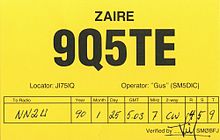DXing
DXen (from DX for "distance" or "distant exchange") means in radio operating technology the attempts to receive distant transmitters or to establish contact with a distant radio station.
Basics
Reception from distant transmitter systems is made possible by reflections of the radio waves in the ionosphere ( long , medium and short wave ), while in the VHF range temporary overreaches in the troposphere or the ionosphere ( Sporadic-E ) enable reception. The reflection behavior of the ionosphere depends on the time of day and the season as well as the sun's activity ( sunspots ). As a specialty of meteorology, there is a radio weather report and propagation forecasts for dispersion conditions .
DX in the amateur radio service

In the amateur radio service , DX (-en) has a similar meaning. Radio links on the shortwave that are made between different continents are considered DX. Another definition states that in the shortwave range, radio links from 3000 km are classified as DX links. In the VHF , UHF and SHF range, radio connections are referred to as DX if they take place over distances beyond the quasi-optical view - for simplification, in the 2-meter band and in the 70-centimeter band at distances of more than 300 km spoken by DX.
DXpeditions (as field days , e.g. on islands that are difficult to access, in countries without local radio amateurs or in the Antarctic) enable DX connections to areas that are seldom accessible via amateur radio. Radio amateurs often confirm DX connections with each other with QSL cards , but since the 1990s the comparison of logbooks via the Internet has also gained in importance. Furthermore, publicly accessible logbooks (online logs) on the Internet, especially from stations that are called by many amateurs, provide an additional possibility of checking whether connections have been successful.
CB radio
DXing is also possible in CB radio , but due to the characteristics of the frequencies around 27 MHz, this is only possible under seldom good propagation conditions.
Broadcast DX
The reception of amplitude-modulated shortwave transmitters is possible with any normal radio that has a receiver for a shortwave frequency band . World receivers offer particularly good conditions for DXing, as they can receive several shortwave bands and, in some cases, have the option of playing back programs in other broadcast types.
Shortwave reception, both from large international broadcasters and from distant local radio broadcasters, is widely practiced as a hobby . In German-speaking Europe alone, shortwave listeners' clubs have more than 4,000 members, who often also deal with remote reception in other wave ranges, in particular the long and medium wave range . Many who practice the DX hobby send audio reports to the broadcasters by post or e-mail and have them confirmed by QSL cards.
All ARD stations and major international broadcasters confirm correct listening reports with QSL cards, as do some domestic broadcasters and non-broadcast broadcasters such as time signaling services , but financial restrictions are increasingly preventing them from being sent. The number of active broadcasters in the long, medium and short wave ranges has also fallen sharply.
Examples
- FM reception of Spanish stations with overreaches in Central Europe.
- Reception of distant NDBs in the long wave range.
- Medium wave reception from European stations in southern Africa.
- Reception of shortwave broadcasts from all over the world.
- Reception of the Morse signal from SAQ on Alexanderson Day ( long wave : transmission frequency 17.2 kHz).
See also
- Overreach
- Association of German-speaking Shortwave Listeners (ADDX eV)
- German amateur radio club
- Austrian Association of Experimental Broadcasters
- Union of Swiss Shortwave Amateurs
- Amateur Radio Association Liechtenstein
literature
- Gregor Häberle, Heinz Häberle, Thomas Kleiber: Expertise in radio, television and radio electronics. 3rd edition, Verlag Europa-Lehrmittel, Haan-Gruiten, 1996, ISBN 3-8085-3263-7
- Stratis Karamanolis: All About CB. A manual for the CB radio operator. 2nd Edition. Karamanolis, Putzbrunn, 1977.
Individual evidence
- ↑ Werner Eckart KW Moltrecht, DJ4UF (5th edition, 2015): Amateur radio course: Operating technology and regulations. Publishing house for technology and craft new media, Baden-Baden. ISBN 978-3-88180-803-3 , page 27
- ↑ DXing - The Art of Listening to Distant signal . Canadian Communications Foundation. Archived from the original on July 22, 2016. Info: The archive link was inserted automatically and has not yet been checked. Please check the original and archive link according to the instructions and then remove this notice. Retrieved August 17, 2016.

